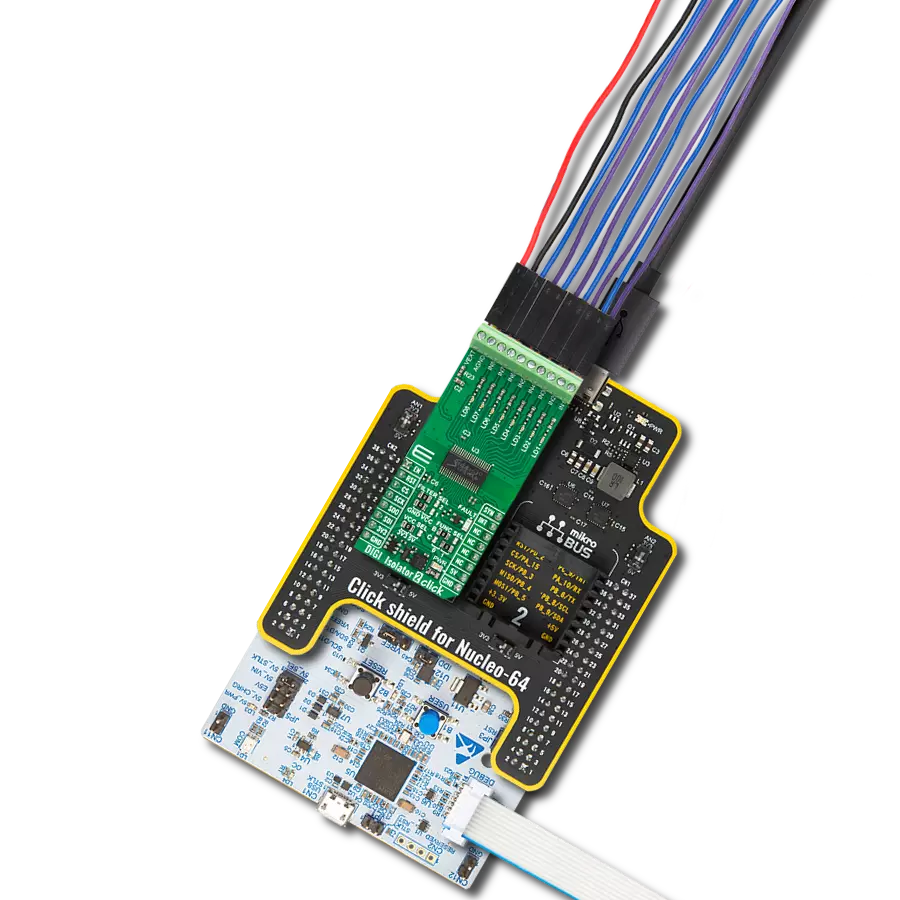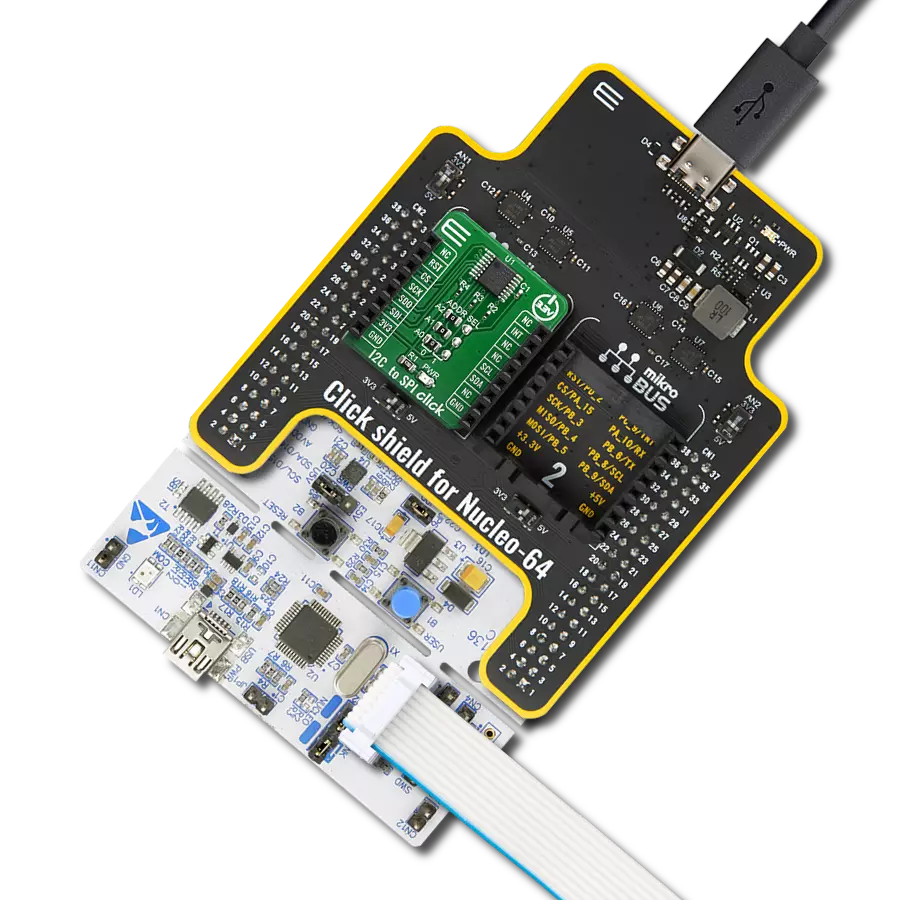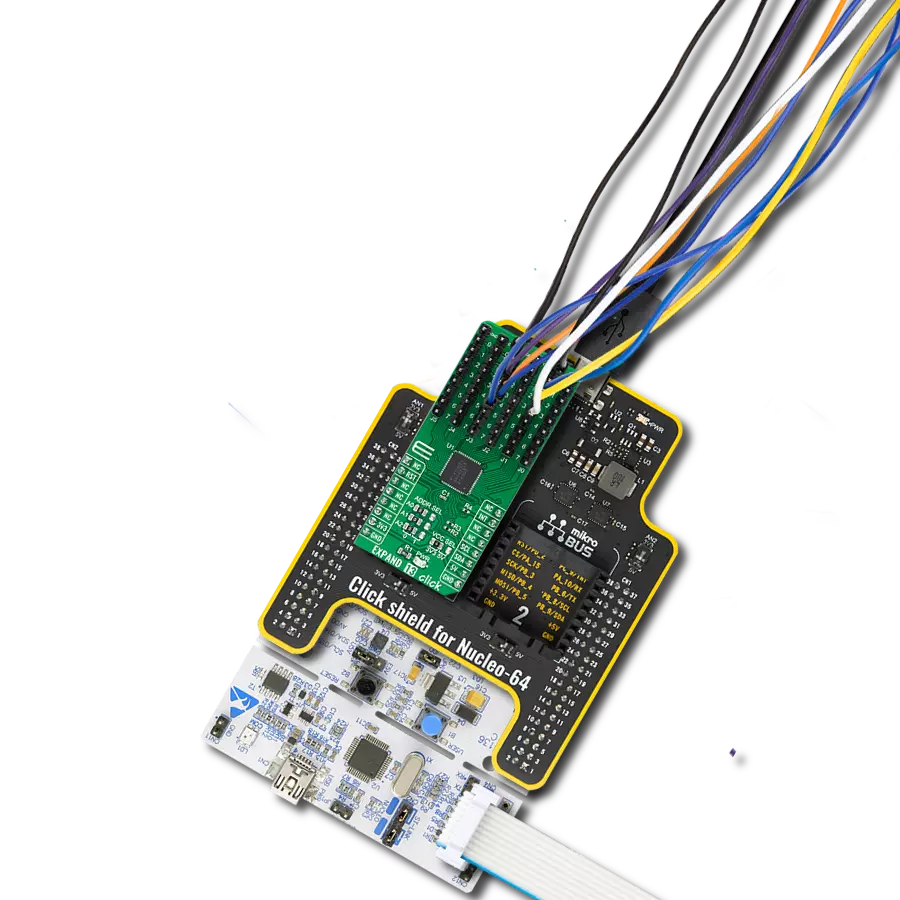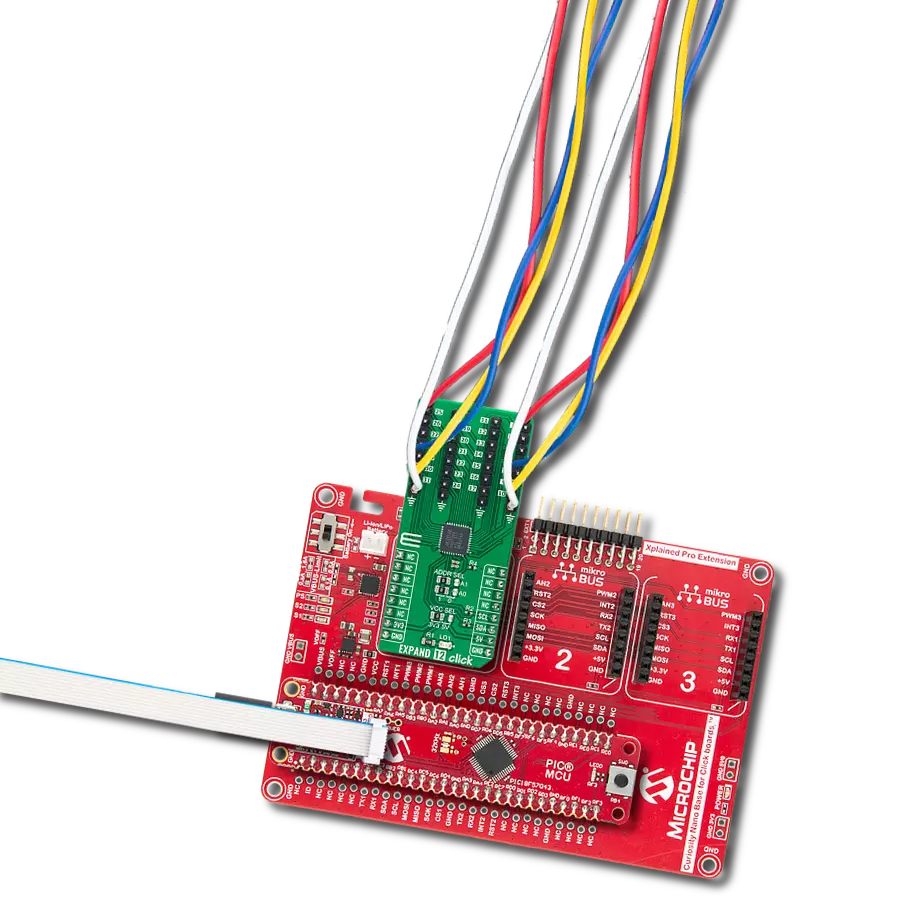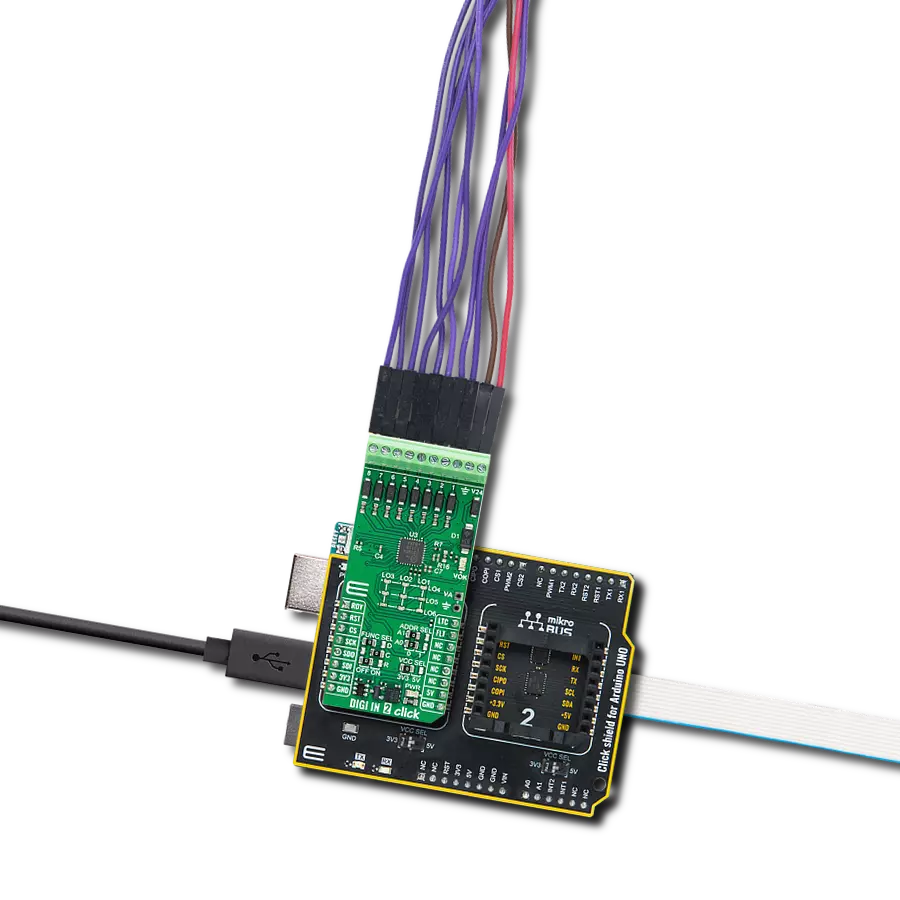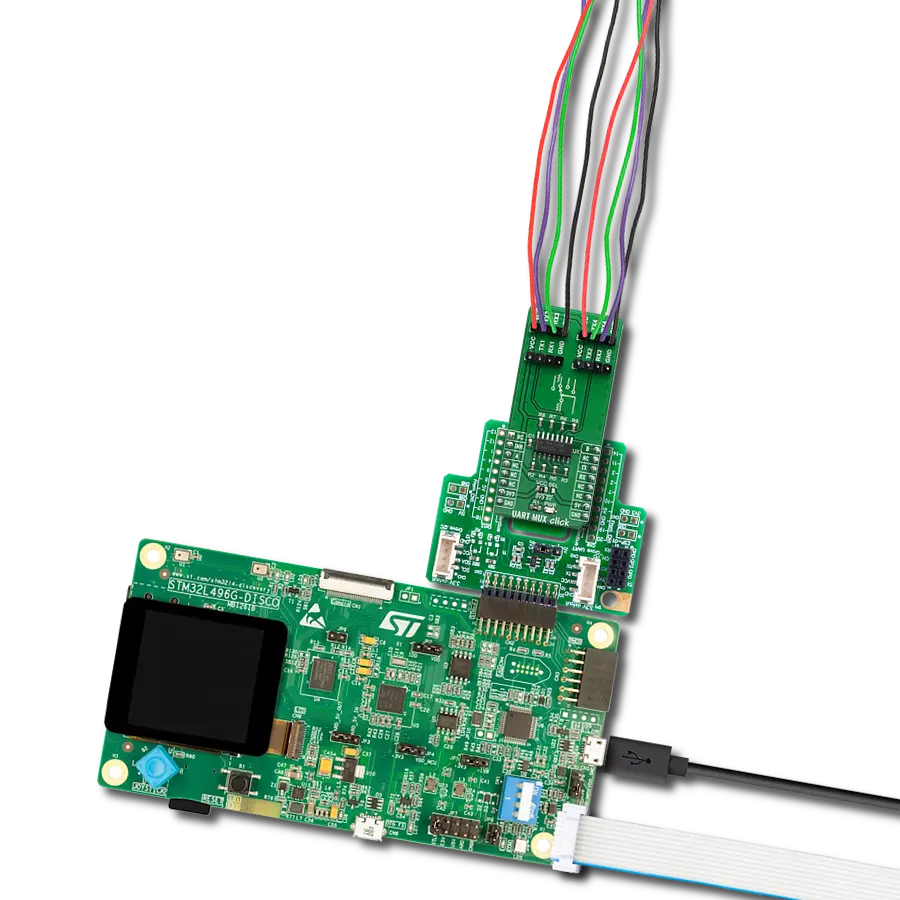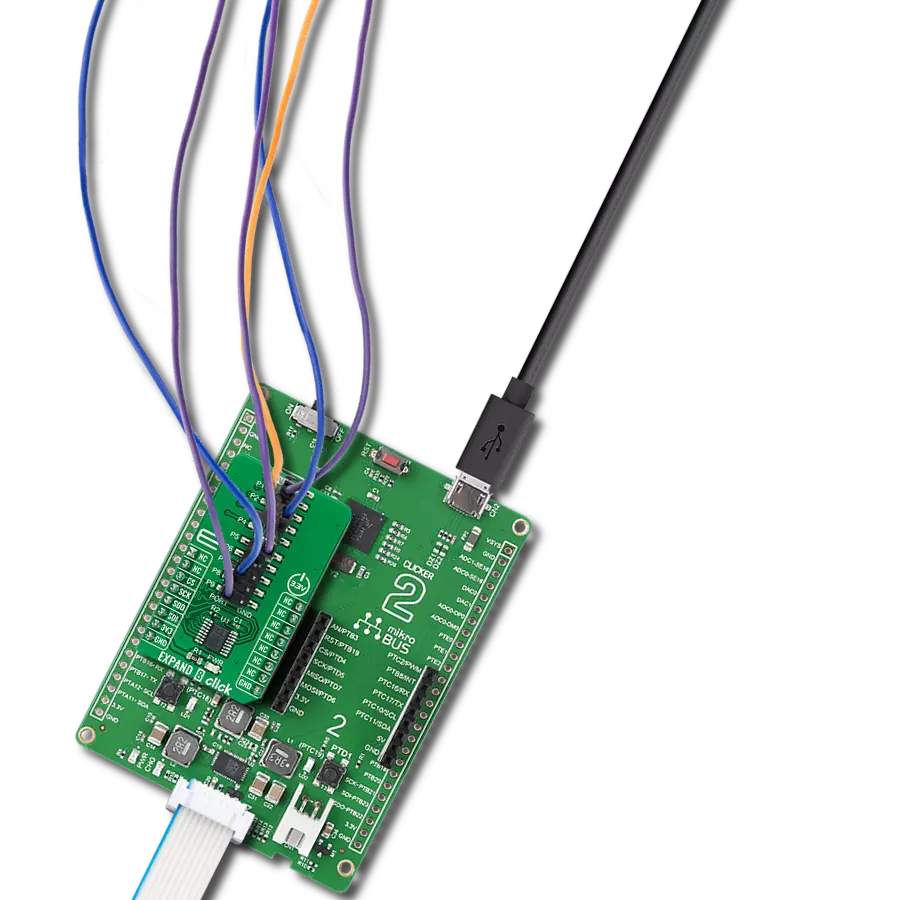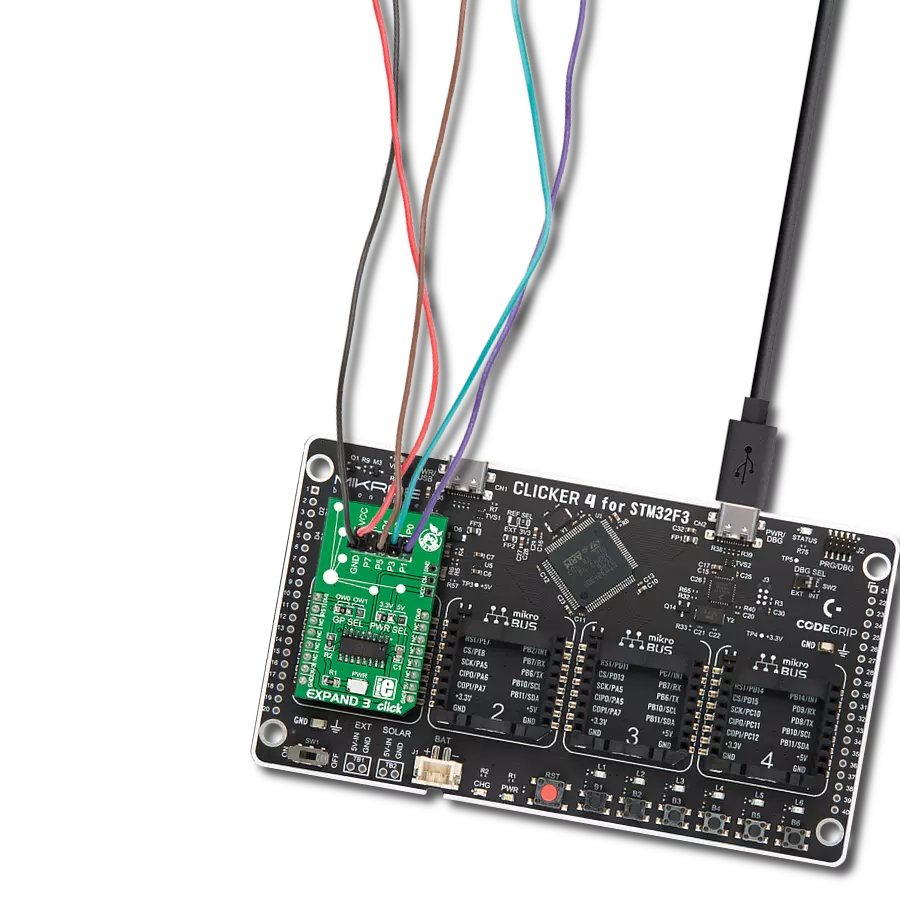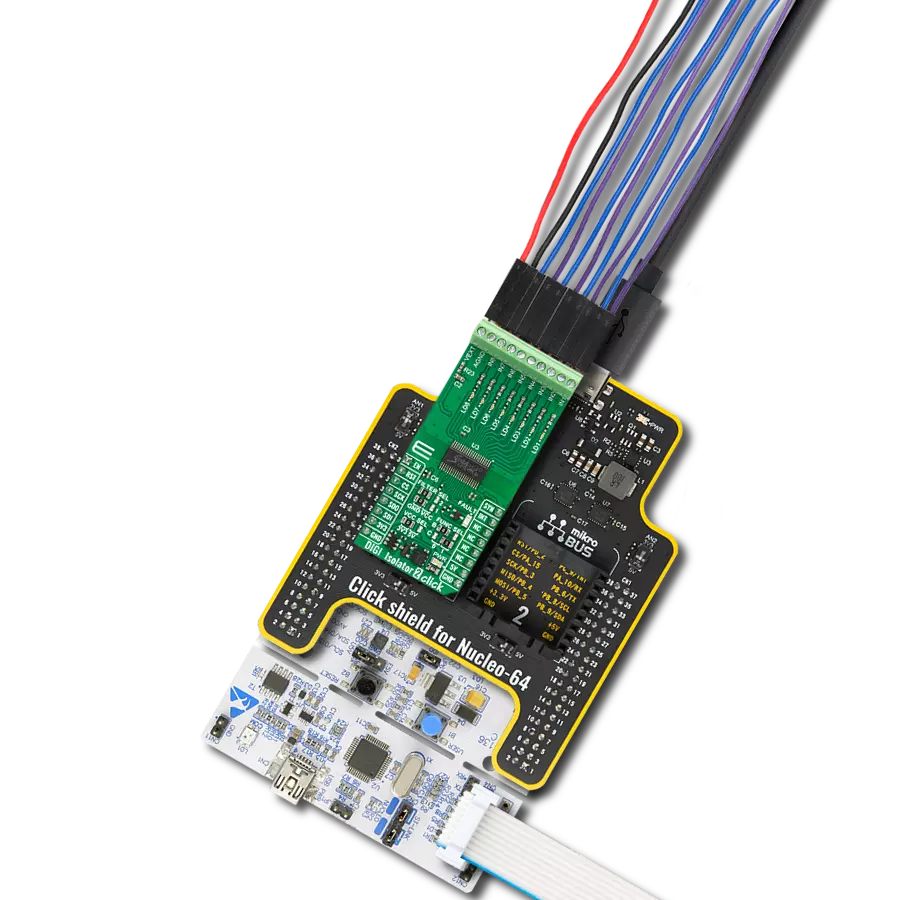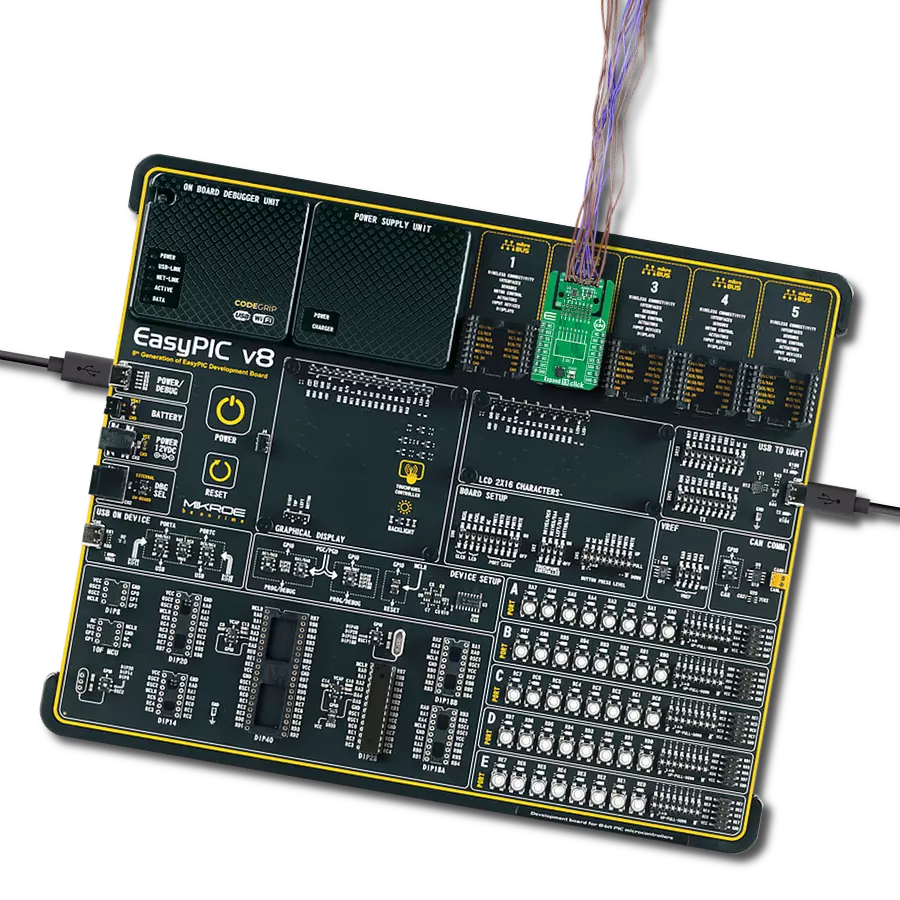Optimize the efficiency of your control systems and smart solutions with our multi-port I/O expander, enabling precise input and output management for data regulation and energy conservation
A
A
Hardware Overview
How does it work?
Expand 15 Click is based on the TCAL6416, a general-purpose I/O expander from Texas Instruments. The TCAL6416 comes in one P-port configuration and allows easy addition of I/O through a standard I2C serial interface. Its digital core consists of 8-bit data registers, allowing users to configure the I/O port characteristics. The I/Os are configured as inputs at Power-On or after a Reset condition. However, the host controller can configure the I/Os as either inputs or outputs by writing to the Configuration registers. The data for each input or output is kept in the corresponding Input Port or Output Port register, with the possibility to invert the polarity of the Input Port with the Polarity Inversion register. The P-port channels configured as outputs can sink up to 25mA for directly driving LEDs, but the current
must be limited externally with additional resistance. Additionally, the TCAL6416 has Agile I/O functionality specifically targeted to enhance the I/O ports, including programmable output drive strength, programmable pull-up and pull-down resistors, latchable inputs, maskable interrupts, interrupt status register, and programmable open-drain or push-pull outputs. These configuration registers improve the I/O by increasing flexibility and allowing users to optimize their design for power consumption, speed, and EMI. This Click board™ communicates with MCU using the standard I2C 2-Wire interface to read data and configure settings with a maximum frequency of 1MHz. Also, the TCAL6416 allows choosing the least significant bits (LSB) of its I2C slave address using the SMD jumper labeled ADDR SEL. It also
possesses a general reset signal routed on the RST pin of the mikroBUS™ socket to reset the TCAL6416 and an additional interrupt signal routed on the INT pin of the mikroBUS™ socket whenever an input port changes state. This Click board™ can only be operated with a 3.3V logic voltage level. Additionally, there is a possibility for the TCAL6416 power supply selection via jumper labeled VCCP SEL to supply the TCAL6416 from 1.08V to 3.6V external power supply (V pin) or with 3V3 mikroBUS™ power rail. The board must perform appropriate logic voltage level conversion before using MCUs with different logic levels. Also, this Click board™ comes equipped with a library containing easy-to-use functions and an example code that can be used as a reference for further development.
Features overview
Development board
Nucleo-64 with STM32L073RZ MCU offers a cost-effective and adaptable platform for developers to explore new ideas and prototype their designs. This board harnesses the versatility of the STM32 microcontroller, enabling users to select the optimal balance of performance and power consumption for their projects. It accommodates the STM32 microcontroller in the LQFP64 package and includes essential components such as a user LED, which doubles as an ARDUINO® signal, alongside user and reset push-buttons, and a 32.768kHz crystal oscillator for precise timing operations. Designed with expansion and flexibility in mind, the Nucleo-64 board features an ARDUINO® Uno V3 expansion connector and ST morpho extension pin
headers, granting complete access to the STM32's I/Os for comprehensive project integration. Power supply options are adaptable, supporting ST-LINK USB VBUS or external power sources, ensuring adaptability in various development environments. The board also has an on-board ST-LINK debugger/programmer with USB re-enumeration capability, simplifying the programming and debugging process. Moreover, the board is designed to simplify advanced development with its external SMPS for efficient Vcore logic supply, support for USB Device full speed or USB SNK/UFP full speed, and built-in cryptographic features, enhancing both the power efficiency and security of projects. Additional connectivity is
provided through dedicated connectors for external SMPS experimentation, a USB connector for the ST-LINK, and a MIPI® debug connector, expanding the possibilities for hardware interfacing and experimentation. Developers will find extensive support through comprehensive free software libraries and examples, courtesy of the STM32Cube MCU Package. This, combined with compatibility with a wide array of Integrated Development Environments (IDEs), including IAR Embedded Workbench®, MDK-ARM, and STM32CubeIDE, ensures a smooth and efficient development experience, allowing users to fully leverage the capabilities of the Nucleo-64 board in their projects.
Microcontroller Overview
MCU Card / MCU
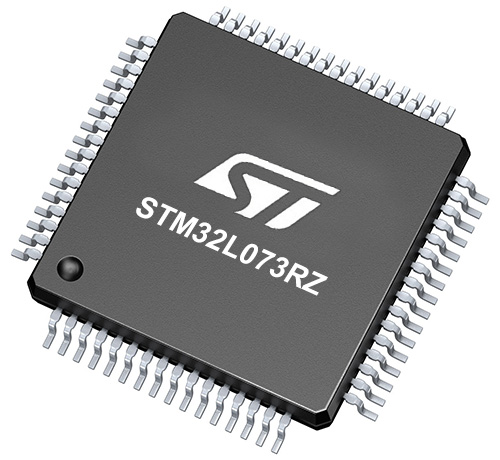
Architecture
ARM Cortex-M0
MCU Memory (KB)
192
Silicon Vendor
STMicroelectronics
Pin count
64
RAM (Bytes)
20480
You complete me!
Accessories
Click Shield for Nucleo-64 comes equipped with two proprietary mikroBUS™ sockets, allowing all the Click board™ devices to be interfaced with the STM32 Nucleo-64 board with no effort. This way, Mikroe allows its users to add any functionality from our ever-growing range of Click boards™, such as WiFi, GSM, GPS, Bluetooth, ZigBee, environmental sensors, LEDs, speech recognition, motor control, movement sensors, and many more. More than 1537 Click boards™, which can be stacked and integrated, are at your disposal. The STM32 Nucleo-64 boards are based on the microcontrollers in 64-pin packages, a 32-bit MCU with an ARM Cortex M4 processor operating at 84MHz, 512Kb Flash, and 96KB SRAM, divided into two regions where the top section represents the ST-Link/V2 debugger and programmer while the bottom section of the board is an actual development board. These boards are controlled and powered conveniently through a USB connection to program and efficiently debug the Nucleo-64 board out of the box, with an additional USB cable connected to the USB mini port on the board. Most of the STM32 microcontroller pins are brought to the IO pins on the left and right edge of the board, which are then connected to two existing mikroBUS™ sockets. This Click Shield also has several switches that perform functions such as selecting the logic levels of analog signals on mikroBUS™ sockets and selecting logic voltage levels of the mikroBUS™ sockets themselves. Besides, the user is offered the possibility of using any Click board™ with the help of existing bidirectional level-shifting voltage translators, regardless of whether the Click board™ operates at a 3.3V or 5V logic voltage level. Once you connect the STM32 Nucleo-64 board with our Click Shield for Nucleo-64, you can access hundreds of Click boards™, working with 3.3V or 5V logic voltage levels.
Used MCU Pins
mikroBUS™ mapper
Take a closer look
Click board™ Schematic

Step by step
Project assembly
Software Support
Library Description
This library contains API for Expand 15 Click driver.
Key functions:
expand15_hw_reset- Expand 15 hardware reset functionexpand15_get_in_pin_state- Expand 15 get input pin state functionexpand15_set_out_pin_state- Expand 15 set output pin state function
Open Source
Code example
The complete application code and a ready-to-use project are available through the NECTO Studio Package Manager for direct installation in the NECTO Studio. The application code can also be found on the MIKROE GitHub account.
/*!
* @file main.c
* @brief Expand 15 Click example
*
* # Description
* This example demonstrates the use of Expand 15 Click board by setting and reading
* the ports state.
*
* The demo application is composed of two sections :
*
* ## Application Init
* Initializes the driver and performs the Click default configuration which sets
* half of the port 0 and port 1 pins as output ( P00, P02, P04, P06, P10, P12, P14 and P16) and the
* half of the port 0 and port 1 pins as inputs ( P01, P03, P05, P07, P11, P13, P15 and P17).
*
* ## Application Task
* Sets the state of the output pins of one port and then reads the status of input pins of that port
* and displays the results on the USB UART approximately 2 seconds.
*
* @note
* In order for this example to work as intended it is necessary to connect the input and output pins
* eg. P00 and P01, P02 and P03 etc. Floating input pins will be shown as a high state.
*
* @author Stefan Ilic
*
*/
#include "board.h"
#include "log.h"
#include "expand15.h"
static expand15_t expand15;
static log_t logger;
void application_init ( void )
{
log_cfg_t log_cfg; /**< Logger config object. */
expand15_cfg_t expand15_cfg; /**< Click config object. */
/**
* Logger initialization.
* Default baud rate: 115200
* Default log level: LOG_LEVEL_DEBUG
* @note If USB_UART_RX and USB_UART_TX
* are defined as HAL_PIN_NC, you will
* need to define them manually for log to work.
* See @b LOG_MAP_USB_UART macro definition for detailed explanation.
*/
LOG_MAP_USB_UART( log_cfg );
log_init( &logger, &log_cfg );
log_info( &logger, " Application Init " );
// Click initialization.
expand15_cfg_setup( &expand15_cfg );
EXPAND15_MAP_MIKROBUS( expand15_cfg, MIKROBUS_1 );
if ( I2C_MASTER_ERROR == expand15_init( &expand15, &expand15_cfg ) )
{
log_error( &logger, " Communication init." );
for ( ; ; );
}
if ( EXPAND15_ERROR == expand15_default_cfg ( &expand15 ) )
{
log_error( &logger, " Default configuration." );
for ( ; ; );
}
log_info( &logger, " Application Task " );
log_printf( &logger, "- - - - - - - - - - - - - - - - - - - - - - - - - - \r\n" );
}
void application_task ( void )
{
uint8_t output_pin_state;
uint8_t input_pin_state;
// Setting port0 output pin ( P00, P02, P04 and P06 ) to high
output_pin_state = EXPAND15_PIN_00_MASK | EXPAND15_PIN_02_MASK | EXPAND15_PIN_04_MASK | EXPAND15_PIN_06_MASK;
expand15_set_out_pin_state( &expand15, EXPAND15_PORT_0, output_pin_state );
Delay_ms ( 10 );
// Checking state of the input pins on port0
expand15_get_in_pin_state( &expand15, EXPAND15_PORT_0, &input_pin_state );
log_printf( &logger, "OUTPUT PINS HIGH \r\n" );
log_printf( &logger, "INPUT PINS |" );
log_printf( &logger, " P01 : %c |", ( ( input_pin_state & EXPAND15_PIN_01_MASK ) ? 'H' : 'L' ) );
log_printf( &logger, " P03 : %c |", ( ( input_pin_state & EXPAND15_PIN_03_MASK ) ? 'H' : 'L' ) );
log_printf( &logger, " P05 : %c |", ( ( input_pin_state & EXPAND15_PIN_05_MASK ) ? 'H' : 'L' ) );
log_printf( &logger, " P07 : %c \r\n", ( ( input_pin_state & EXPAND15_PIN_07_MASK ) ? 'H' : 'L' ) );
Delay_ms ( 500 );
// Setting port0 output pin ( P00, P02, P04 and P06 ) to low
output_pin_state = EXPAND15_ALL_PINS_OFF;
expand15_set_out_pin_state( &expand15, EXPAND15_PORT_0, output_pin_state );
Delay_ms ( 10 );
// Checking state of the input pins on port0
expand15_get_in_pin_state( &expand15, EXPAND15_PORT_0, &input_pin_state );
log_printf( &logger, "OUTPUT PINS LOW \r\n" );
log_printf( &logger, "INPUT PINS |" );
log_printf( &logger, " P01 : %c |", ( ( input_pin_state & EXPAND15_PIN_01_MASK ) ? 'H' : 'L' ) );
log_printf( &logger, " P03 : %c |", ( ( input_pin_state & EXPAND15_PIN_03_MASK ) ? 'H' : 'L' ) );
log_printf( &logger, " P05 : %c |", ( ( input_pin_state & EXPAND15_PIN_05_MASK ) ? 'H' : 'L' ) );
log_printf( &logger, " P07 : %c \r\n", ( ( input_pin_state & EXPAND15_PIN_07_MASK ) ? 'H' : 'L' ) );
log_printf( &logger, "- - - - - - - - - - - - - - - - - - - - - - - - - - \r\n" );
Delay_ms ( 1000 );
Delay_ms ( 1000 );
// Setting port1 output pin ( P10, P12, P14 and P01 ) to high
output_pin_state = EXPAND15_PIN_10_MASK | EXPAND15_PIN_12_MASK | EXPAND15_PIN_14_MASK | EXPAND15_PIN_16_MASK;
expand15_set_out_pin_state( &expand15, EXPAND15_PORT_1, output_pin_state );
Delay_ms ( 10 );
// Checking state of the input pins on port1
expand15_get_in_pin_state( &expand15, EXPAND15_PORT_1, &input_pin_state );
log_printf( &logger, "OUTPUT PINS HIGH \r\n" );
log_printf( &logger, "INPUT PINS |" );
log_printf( &logger, " P11 : %c |", ( ( input_pin_state & EXPAND15_PIN_11_MASK ) ? 'H' : 'L' ) );
log_printf( &logger, " P13 : %c |", ( ( input_pin_state & EXPAND15_PIN_13_MASK ) ? 'H' : 'L' ) );
log_printf( &logger, " P15 : %c |", ( ( input_pin_state & EXPAND15_PIN_15_MASK ) ? 'H' : 'L' ) );
log_printf( &logger, " P17 : %c \r\n", ( ( input_pin_state & EXPAND15_PIN_17_MASK ) ? 'H' : 'L' ) );
Delay_ms ( 500 );
// Setting port1 output pin ( P10, P12, P14 and P16 ) to low
output_pin_state = EXPAND15_ALL_PINS_OFF;
expand15_set_out_pin_state( &expand15, EXPAND15_PORT_1, output_pin_state );
Delay_ms ( 10 );
// Checking state of the input pins on port1
expand15_get_in_pin_state( &expand15, EXPAND15_PORT_1, &input_pin_state );
log_printf( &logger, "OUTPUT PINS LOW \r\n" );
log_printf( &logger, "INPUT PINS |" );
log_printf( &logger, " P11 : %c |", ( ( input_pin_state & EXPAND15_PIN_11_MASK ) ? 'H' : 'L' ) );
log_printf( &logger, " P13 : %c |", ( ( input_pin_state & EXPAND15_PIN_13_MASK ) ? 'H' : 'L' ) );
log_printf( &logger, " P15 : %c |", ( ( input_pin_state & EXPAND15_PIN_15_MASK ) ? 'H' : 'L' ) );
log_printf( &logger, " P17 : %c \r\n", ( ( input_pin_state & EXPAND15_PIN_17_MASK ) ? 'H' : 'L' ) );
log_printf( &logger, "- - - - - - - - - - - - - - - - - - - - - - - - - - \r\n" );
Delay_ms ( 1000 );
Delay_ms ( 1000 );
}
int main ( void )
{
/* Do not remove this line or clock might not be set correctly. */
#ifdef PREINIT_SUPPORTED
preinit();
#endif
application_init( );
for ( ; ; )
{
application_task( );
}
return 0;
}
// ------------------------------------------------------------------------ END
Additional Support
Resources
Category:Port expander



















